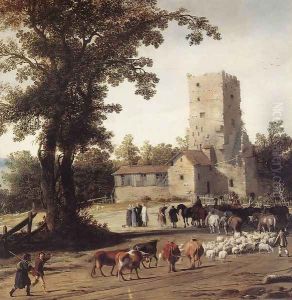Pieter Jansz. Post Paintings
Pieter Jansz. Post was a notable Dutch architect, painter, and printmaker born in Haarlem, Netherlands, in 1608. He is primarily remembered for his significant contributions to Dutch Baroque architecture, working closely with his contemporary and brother-in-law, Jacob van Campen. Together, they played pivotal roles in defining the architectural aesthetic of the Dutch Golden Age, particularly through their involvement in the design and construction of the Mauritshuis in The Hague and the Amsterdam Town Hall, now known as the Royal Palace of Amsterdam.
Post's architectural style was characterized by its classical restraint and incorporation of elements derived from Italian Renaissance and French Classical architecture, which was somewhat innovative for the Netherlands during that period. His designs often featured harmonious proportions, grand entrances, and the use of pilasters and pediments, which became hallmark features of Dutch classical architecture. Besides his work on public and government buildings, Post also designed numerous country houses and estates in the Dutch Republic, showcasing his versatility and understanding of different architectural requirements and settings.
In addition to his architectural endeavors, Post produced a number of paintings and prints, although these are less well-documented and studied compared to his architectural works. His artistic output reflects the broader interests of the Dutch Golden Age, encompassing landscapes, architectural studies, and possibly genre scenes, aligning him with the era's fascination with the depiction of everyday life and the natural world.
Pieter Jansz. Post died in 1669, leaving behind a legacy that significantly influenced the development of Dutch architecture. His works continue to be studied and admired for their beauty, historical importance, and their role in the transition of Dutch architectural practice from the Renaissance influences to a more distinctly Dutch classical style. Post's contributions were not only pivotal in shaping the architectural landscape of his time but also in laying the groundwork for future generations of architects in the Netherlands and beyond.
